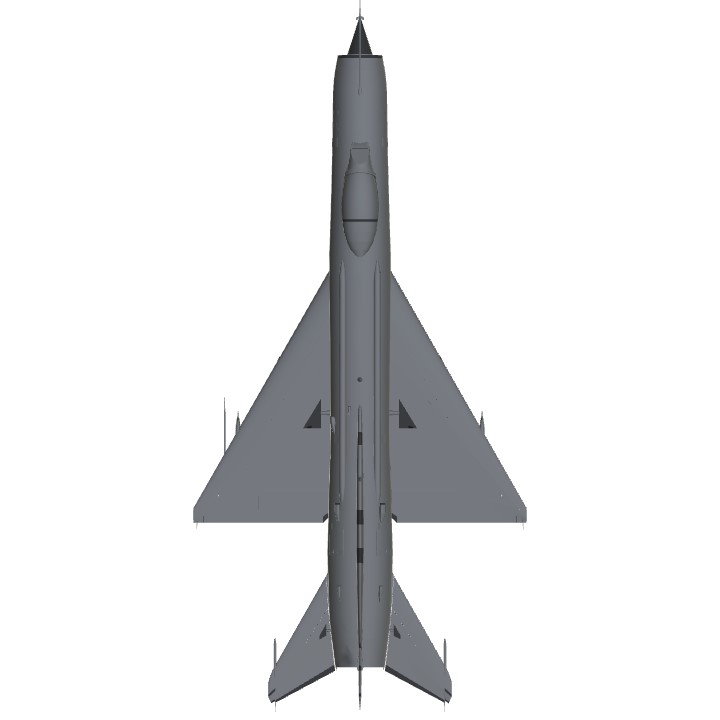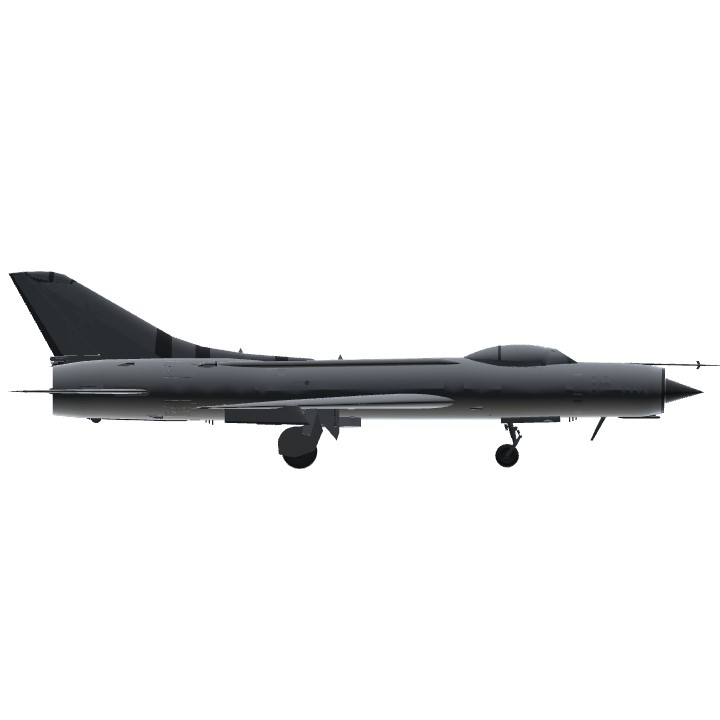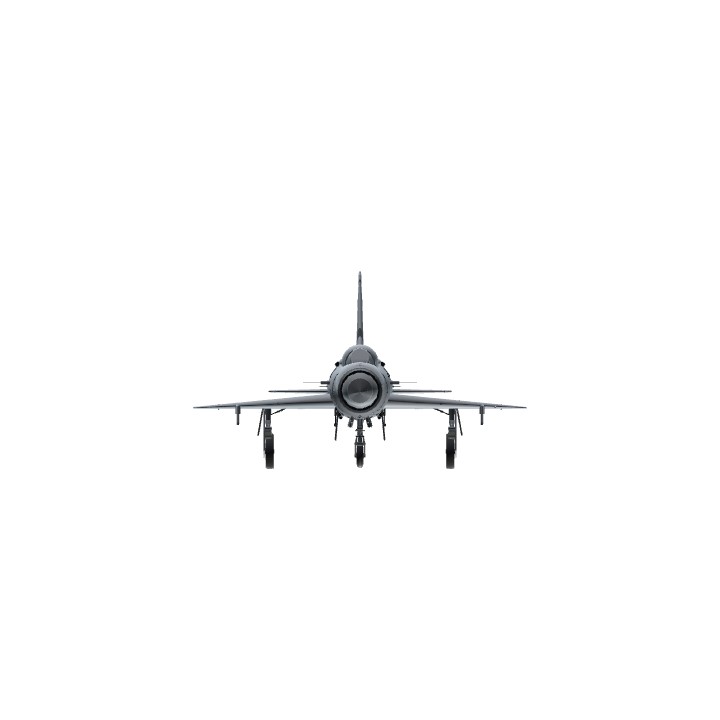Features:
Working Mach and G meters. The Mach meter is accurate, assuming standard day conditions (15 degrees C at S.L. and -2 degrees/1000' lapse rate).
Mach effects have been incorporated for both the shock cone, which operates between Mach 1.5 - 2.2, as well as reduced turn rates when flying in excess of Mach 1.0.
Buffeting has been incorporated with increasing angles of attack. Light buffet is good, heavy buffet is bad (read notes below).
1:1 scale, accurate weights, fuel quantity, performance (Mach 2.2 at 41,000' / 12500 meters), turn capability with energy loss, accurate maximum ceiling (mid-60,000' / 19,800 meters), takeoff and landing distances and weaponry.
Controls:
Standard pitch, roll and yaw. Yaw also controls nosewheel steering on ground below 55 knots / 28 m/s.
AG1 - Nav & Landing Lights (Deploy with LG)
AG2 - Radar
AG3 - Jettison Drop Tanks
AG4 - Drag Chute
AG5 - Jettison Missiles
AG6 - Open
AG7 - Open
AG8 - Reserved
Brake - Speedbrakes and wheel brakes
VTOL - Flaps
Trim - Trim
Takeoff:
- Set takeoff trim (1/2 notch down), LEAVE FLAPS UP.
- Apply MAX power (AB engages at 99% RPM).
- Begin to apply back stick pressure at 160 KIAS / 300 kph indicated, rotate to approximately 5 degrees nose high.
- Jet should fly off at 180 KIAS / 335 kph indicated.
- Retract landing gear immediately once safely away.
WARNING: Ensure aircraft is safely away with a positive rate of climb prior to raising landing gear. Do not allow aircraft to settle into runway just after liftoff.
NOTE: Slightly releasing back stick pressure and trimming nose down slightly once safely airborne to reduce the angle of attack and induced drag will increase acceleration rates following takeoff. Do not allow the aircraft to settle back into the runway.
Ivan Says: "Comrade! This aircraft has a symmetric wing...you can feel the maximum turn performance on the light buffet and see the light shaking on the instrument panel. But, pull too hard on the stick and the jet will buffet heavily, resulting in unacceptable airspeed loss, which not only waste's the People's jet fuel, it can result in a stall during landing approach or getting your mount shot out from underneath you by a NATO Phantom. Pull hard enough to get to the tickle, but avoid the heavy buffet!"
Maximum Load Limitation: +7 G.
Maximum Speed Limitation: Mach 2.2, though aircraft is capable of exceeding this speed.
CAUTION: Pilot attention is required to prevent airspeed exceedance when flying at high Mach numbers at high altitude.
Flight Characteristics:
With the big delta wing, the initial rate of turn is extremely good for the first 180 degrees ("bat turn"), but energy loss is very high at increased angles of attack and/or G loads in excess of 5 Gs. Use of afterburner is required to sustain best rates of turn for as long as possible and a tradeoff of altitude may be required to minimize speed loss.
Best acceleration is achieved by “unloading”—relaxing back stick pressure slightly to 1/2 G, lowering the angle of attack and induced drag. Useful in all phases of flight when best acceleration is required and during combat engagements.
Best initial rates of turn are achieved at high indicated airspeeds, but less than Mach 1.0 and on the "tickle".
CAUTION: When slowing below Mach 1.0, turn rate and G loading will increase abruptly during the transition, use caution to prevent exceeding maximum load factors (+7 G).
If attempting to slow the aircraft, a turn at increased G is very effective to slow. The speedbrakes are also very effective to slow the aircraft.
Aileron forces are light and roll rate is very good with power boosted controls in all 3 axes. Rudder is effective for rolling the aircraft and may be preferable in place of using ailerons when rolling at very high angles of attack.
Airbrakes are extremely effective.
Approach and Landing:
Slow below 250 KIAS / 460 kph indicated airspeed prior to extending landing gear. Lower flaps to full. Slow to no slower than 160 KIAS / 300 kph indicated airspeed on final, approximately 65% RPM. Approach should be flown "on the tickle"...the instrument panel will lightly shake. Approaching the underrun, reduce power to idle (0% RPM) and flare slightly. Deploy drag chute (AG4) as required to reduce landing roll.
WARNING: Allowing aircraft to slow excessively on final will lead to a high sink rate and impending stalled condition. Simply pulling back on the stick will only aggravate a shallow, low glide path. Add power, accelerate and slightly reduce AoA if necessary, to correct glide path. If not corrected, a stall accompanied by wing roll off in excess of 60 degrees is possible. Should an approach stall accompanied by roll off be encountered, aileron WILL aggravate the adverse roll, correct the situation by simultaneously relaxing back stick pressure to lower the angle of attack below the critical AoA, advancing the throttle to MAX power, rolling to wings level using a combination of rudder and ailerons and arresting the sink rate.
CAUTION: Allowing aircraft to slow excessively on short final will lead to a dropped in landing, sometimes accompanied by a bounce and possible aircraft damage. If encountering a bounce, release a small amount of back stick pressure to arrest the height above the runway and arrest the sink rate just prior to re-contacting the runway. Do not allow the nose to contact the runway surface first.
Ivan Says: "Comrade! In order to land on speed, you must fly final "on the tickle"...observe the instrument panel lightly shaking. However, fly any slower and getting to the heavy, low frequency buffett which indicates a stalled condition, will kill you! Unless you want a State funeral, Order of the Red Star and your family to receive a middling pension for the rest of their lives, you would best avoid the heavy buffett on final!"
Happy hunting and fly safe!
Specifications
General Characteristics
- Predecessor !!Sukhoi Su-11 Fishpot C
- Created On Windows
- Wingspan 28.2ft (8.6m)
- Length 60.0ft (18.3m)
- Height 19.3ft (5.9m)
- Empty Weight 19,320lbs (8,763kg)
- Loaded Weight 26,805lbs (12,158kg)
Performance
- Power/Weight Ratio 0.922
- Wing Loading 53.6lbs/ft2 (261.7kg/m2)
- Wing Area 500.0ft2 (46.5m2)
- Drag Points 1252
Parts
- Number of Parts 936
- Control Surfaces 2
- Performance Cost 3,710




